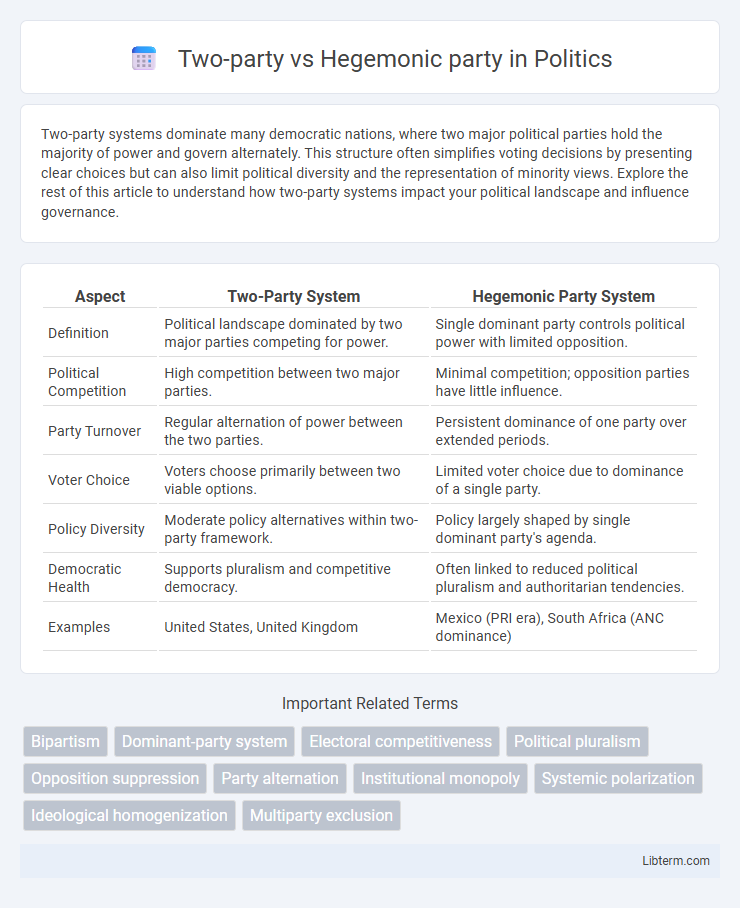Two-party systems dominate many democratic nations, where two major political parties hold the majority of power and govern alternately. This structure often simplifies voting decisions by presenting clear choices but can also limit political diversity and the representation of minority views. Explore the rest of this article to understand how two-party systems impact your political landscape and influence governance.
Table of Comparison
| Aspect | Two-Party System | Hegemonic Party System |
|---|---|---|
| Definition | Political landscape dominated by two major parties competing for power. | Single dominant party controls political power with limited opposition. |
| Political Competition | High competition between two major parties. | Minimal competition; opposition parties have little influence. |
| Party Turnover | Regular alternation of power between the two parties. | Persistent dominance of one party over extended periods. |
| Voter Choice | Voters choose primarily between two viable options. | Limited voter choice due to dominance of a single party. |
| Policy Diversity | Moderate policy alternatives within two-party framework. | Policy largely shaped by single dominant party's agenda. |
| Democratic Health | Supports pluralism and competitive democracy. | Often linked to reduced political pluralism and authoritarian tendencies. |
| Examples | United States, United Kingdom | Mexico (PRI era), South Africa (ANC dominance) |
Understanding Two-Party Systems
Two-party systems are political frameworks where two dominant parties consistently control government leadership, shaping policy and electoral competition. In contrast, hegemonic party systems feature a single party maintaining prolonged control, often limiting genuine political opposition. Understanding two-party systems reveals their role in promoting political stability, clear policy choices, and voter alignment across major ideological spectrums.
Defining Hegemonic Party Structures
Hegemonic party structures centralize political power within a single dominant party that controls government institutions and suppresses opposition, contrasting sharply with two-party systems where power oscillates between two competing parties. Characterized by hierarchical organization, hegemonic parties maintain control through patronage networks, extensive grassroots mobilization, and state resources. This dominance often results in limited political pluralism, undermining democratic processes inherent in two-party frameworks that allow substantive competition and accountability.
Historical Evolution of Political Party Systems
The historical evolution of political party systems reveals distinct patterns between two-party and hegemonic party frameworks. The two-party system, prominently seen in countries like the United States, evolved through electoral laws such as single-member district plurality, reinforcing competition between two dominant parties. In contrast, hegemonic party systems often emerged in post-colonial or authoritarian contexts, where a single party maintains prolonged dominance through institutional control, suppression of opposition, and patronage networks.
Key Differences Between Two-Party and Hegemonic Systems
Two-party systems feature two dominant political parties competing for power, promoting political balance and often leading to a stable government structure, whereas hegemonic party systems maintain prolonged dominance by a single party, limiting genuine competition. In a two-party system, voter choice is clearer, and power alternates between parties, while hegemonic systems suppress opposition through controlled elections or legal restrictions. The key difference lies in political pluralism and competition, with two-party systems encouraging democratic processes and hegemonic systems often undermining political diversity.
Electoral Dynamics and Voter Choice
Two-party systems foster clearer electoral dynamics by offering voters distinct policy alternatives, simplifying decision-making and often leading to higher voter turnout due to perceived stakes. In contrast, hegemonic party systems limit genuine competition, reducing voter choice and potentially lowering electoral engagement as the dominant party controls political discourse and candidate selection. Voter behavior in two-party contexts reflects strategic voting and issue-based preferences, while in hegemonic systems, loyalty and patronage networks often drive electoral outcomes.
Governance and Policy Implications
Two-party systems often promote stable governance by encouraging coalition-building and clearer policy mandates, whereas hegemonic party systems may centralize power, reducing political competition and potentially limiting policy diversity. Governance under a hegemonic party can lead to efficient decision-making but risks authoritarian tendencies and decreased accountability. Policy implications include more dynamic legislative debates in two-party systems, contrasted with streamlined yet potentially less inclusive policy development in hegemonic party frameworks.
Stability and Political Competition
Two-party systems promote political stability by encouraging broad coalitions and providing clear choices to voters, reducing fragmentation and fostering consistent governance. In contrast, hegemonic party systems often limit genuine political competition, as a dominant party maintains control through institutional advantages, reducing incentives for opposition parties to challenge power effectively. Stability in hegemonic systems may result from suppressed competition rather than democratic consensus, risking stagnation and potential unrest over time.
Democratic Representation in Each System
Two-party systems often streamline democratic representation by consolidating political competition, enabling clearer policy choices and stable governance, while potentially marginalizing minority voices. Hegemonic party systems dominate political landscapes by centralizing power within a single dominant party, which can undermine pluralistic representation and reduce electoral competitiveness. The balance between effective governance and inclusive representation differs significantly, as two-party systems promote contestation whereas hegemonic parties risk entrenching authoritarian tendencies.
Case Studies: Global Examples
The United States exemplifies a stable two-party system dominated by the Democratic and Republican parties, fostering competitive elections and policy shifts. In contrast, China represents a hegemonic party system where the Chinese Communist Party maintains centralized political control with limited opposition. India showcases a hybrid case with dominant parties like the Indian National Congress and BJP coexisting with regional parties, illustrating the complexities of multi-party democracy within a hegemonic influence framework.
Future Trends and Reform Possibilities
Future trends in two-party systems indicate growing polarization and voter dissatisfaction, prompting calls for electoral reforms such as ranked-choice voting to enhance representation and reduce partisan gridlock. Hegemonic party systems may face pressures from emerging opposition movements and demands for inclusive governance, sparking discussions on democratization and power decentralization. Reform possibilities include the introduction of proportional representation mechanisms to balance power dynamics and increase political plurality within both frameworks.
Two-party Infographic

 libterm.com
libterm.com